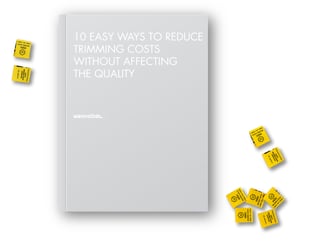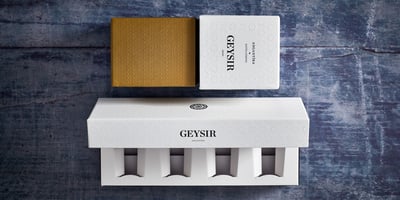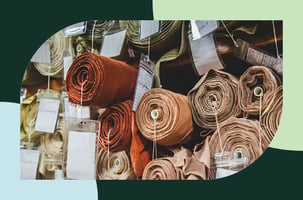A Guide to Successful Garment Branding
2 min read timeFor a brand to survive in today's market, it has to have a relatable purpose that resonates. Now...
Branding
5 Minute Read
Written by Weavabel, published 24/10/17 10:00

It is widely acknowledged in the fashion industry that a natural disconnect is often at work between creatives and commercials. The creative wants to spend more to create a more saleable product over against the commercial who wants to cut expenditure to deliver a greater profit to the bottom line. Both viewpoints are required to be successful in the volatile fashion world so this report looks deeper into the views, looks into the issues that this disparity causes and provides recommendations to channel creative energy so that they work with the financial goals.
The Creative Aspect
Designers are often like children playing with conkers. Instead of parks and places with trees in the area, designers visit trade fairs to gather their ideas. The objective for children is to 'find the biggest and the best', the fashion designer is trying to find creative ways to apply the trends of the day to create a 'WOW' impression with their product. Instead of stringing up conkers and competing in the playground, the creatives are filling stores and competing with their multi-channel retail strategies. Both are never totally sure how their product will perform and sometimes ideas that have been locked away in the airing cupboard produce consistent results year after year!
Unfortunately for the creative, if their collection fails to perform, just like children go get a new conker, their company will move them on and install new creative blood. In order to limit the chances of failure, creatives are always wanting to invest more in maintaining brand image. Designers often struggle to justify this extra spend so become very frustrated when their project is slashed by commercial who cannot justify the extra spend with Return On Investment (ROI).
Their aspect is: Is there a fashion branding supplier than can provide us with ways to reduce cost on branding without impacting quality or design?
The Commercial Aspect
The commercial on the other hand is like a parent with high mortgage commitments, their priority is to get everything they need to look after their family whilst keeping on top of their bills. For the parent, the main thing that matters to them is dependable income and similarly for the commercial, what matters is that they meet budget and that any time investment yields greater ROI.
For the accountant, trims a necessary evil which are needed to sell the product, similarly to electricity in the household. Instead of conserving electricity by turning the lights off when leaving the room, the commercial is reducing the number of label options to increase efficiency and reduce waste. Instead of checking on Energy helpline, the commercial gets quotes from several trim suppliers and even tries going local to get the very best deal. The creative view of spending more to accumulate more makes the accountant cringe unless it can be justified by a tangible improvement in profit.
So their question simply is: How can I reduce my branding costs?
What issues do these diverse views lead to in fashion business?
Trims become a grey area where disagreement festers and accommodating each aspect is the status quo. No proper benchmark and continuous improvement scheme is put in place because the vastly different individual goals take priority over the overall goal to deliver the collection on time to generate maximum results. Trims are often relegated in importance which means costs increase and leaves a void of expertise which leaves the brand weak so other more proactive brands gain the market share.
Because the two approaches are so different, trim packs often end up out of sync with brand and market position. Extra investment in trims is often ruled out because it is too expensive to be workable which means that design talent is wasted. This could have been spent elsewhere eg. shaping the customer experience or developing the eCommerce site, instead it goes nowhere and reduces bottom line profit. The fact that a proposal could have already cost the business thousands of pounds before the commercial throws it out is often overlooked.
These internal frictions slow down the development process which results in trim packs being reworked last minute. This can lead to air freight costs as deadlines are missed and leaves the business unable to negotiate and plan logistics effectively which result in less profit. Ultimately the fashion company loses out on sales because their competitors get equivalent ranges out to market faster which can lead to excess stocks which have to be heavily discounted to be turned into cash.
What can be put in place to leverage the design flare and ensure financial objectives are met?
Clear Budget: When the designer is working to a clear goal they can tailor their creative energies to get the very best solution to fit in with the overall plan. This means that they are checking the material costs before it is too late to find substitutes and will ensure that the trim package synchronises with the overall brand strategy. In order to set a clear goal, a benchmark can be set based on historical data. This is known as the Trim Profit Cost © and can also be used to increase profits while maintaining brand image.
Critical Path: To ensure everything runs on time use Critical Path which can be managed with regular reporting. This points up the key deadlines and builds in slack for resampling the trims so that the very best outcomes can be achieved without running behind schedule. This enables decisions to be made to reduce the cost of goods sold to increase gross profit. A practical example of this is planning ahead to bring packaging and trims to the point of use by sea freight which is 'is generally between 4-6 times cheaper than air-freight'.
Project Management: When several people are involved with diverse views it is important that final responsibility is delegated to a Project Manager to ensure deadlines are met and the trim package is within budget. This role also involves implementing improvements to drive efficiency and cost savings on a seasonal basis. This could even be farmed out to the account manager at the trim supplier to contain overheads as they have a lot of expertise at their fingertips which can bring serious improvements to profitability whilst maintaining brand image.
In conclusion, both Creative and Commercial aspects are required to leverage the design flare and ensure financial objectives are met. It would be recommended that a clear budget based on Trim Profit Cost is set, timing is managed using a critical path and a Project Manager, who could be from the existing supply base, is installed to contain cost. Rather than letting these divisions fester, it would be highly beneficial to the bottom line to speak to a Trim Development and Supply Consultant who can help implement these tools to maximise input of the creative and commercial aspects on their process from design to delivery.
Get the e-book on how the commercial can reduce your trim costs without affecting the design and creative image of your brand.

Want to keep up to date with industry developments, trends, product launches and more? Sign up to our newsletter to get the latest delivered to your inbox.


